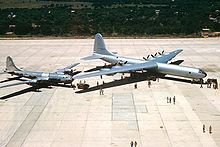Wikipedia:WikiProject Military history/News/December 2016/Book reviews
|
Bigger Bombs for a Brighter Tomorrow |

![]()
![]()
![]()
![]()
![]()
- By Hawkeye7
When World War II ended, the United States was the only country with nuclear weapons. Many assumed that this would be a trump card in world affairs, and that if a war came, the Strategic Air Command (SAC) would soon end it with a few well-placed atomic bombs. This book details what a paper tiger the American nuclear deterrent was before 1950.
The wartime Manhattan Project had created fissile uranium-235 for bombs, but the calutrons could not enrich enough uranium to produce more than one Little Boy bomb before the war ended, partly because the they were poor at enrichment, and partly because the design made such inefficient use of fissile material. Both problems were solved before the completion of the Manhattan Project at the end of 1946, the former by the development of the more effective gaseous diffusion technology, the latter by employing uranium and plutonium together in a composite core for an implosion-type nuclear weapon. However, the new core design would not be tested until the Operation Sandstone nuclear tests in 1948.
Plutonium had been more plentiful in 1945, but by 1946 the rectors at the Hanford Site were breaking down owing to Wigner's disease - swelling of the graphite neutron moderator caused by the carbon atoms being knocked out of alignment by collisions with neutrons. This was very serious; although plutonium cores could be stockpiled indefinitely, the same could not be said about the polonium neutron initiators, without which the bombs would not explode. Two more reactors were ordered at Hanford, but the first would not become operational until October 1949. Graphite and natural uranium had been used at Hanford because enriched uranium and heavy water had not been available in 1943. The Manhattan Project had changed all this, but not until 1950 would work start on building heavy water reactors at the Savannah River Site.
There weren't actually any bombs in the stockpile per se, just parts that could be assembled into bombs. By August 1946, having expended two Fat Man bombs in the Operation Crossroads nuclear tests, there were enough parts to build nine bombs. By August 1947, the stockpile had grown to 13. Assembling a Fat Man bomb was a laborious task. The Armed Forces Special Weapons Project formed three 109-man bomb assembly teams in 1947 and 1948. It took up to two weeks to assemble a bomb in 1946, but this improved with experience. Once assembled, it had to used within 24 hours or the lead-acid batteries would have to be re-charged, which involved partial disassembly. The Los Alamos Scientific Laboratory worked on new designs which would be easier and safer to store, assemble, test and maintain, but the Mark 4 nuclear bomb would not be delivered until 1949.
Of course, once the bombs were assembled, they would have to be transported from Sandia Base, where they were all stockpiled at a forward base. Assembly would have to be completed overseas, as it was inadvisable to fly live bombs across populated areas of the United States. Of the 46 Silverplate B-29s built during the war, and the 19 built after the war and delivered by 1947, only 32 were operational at the start of 1948. No other USAF aircraft could carry the Fat Man. All were operated by a single outfit, the 509th Bomb Group at Walker Air Force Base in Roswell, New Mexico. In 1948, the USAF initiated a new program called Saddletree, which would upgrade 80 B-29s, 36 B-50As, 23 B-50Bs and 18 B-36Bs to make them nuclear-capable. Regrettably, the B-36A could not carry nuclear weapons.
Most of the targets in the Soviet Union were beyond the radius of the B-29, but could the USAF afford to expend its few Silverplate B-29s and trained crews on one-way missions? Would they be able able to find their targets? A training exercise in which the SAC's B-29s attempted to locate Dayton, Ohio, in the dark did not provide much encouragement on that score. But if the bombers flew over the Soviet Union in broad daylight, what would their chances be against Soviet MiG-15s? And what exactly were the targets in Soviet Union? Air intelligence scrambled to compile target lists.
All of this is well-covered in a readable but in-depth work. Much of the ground has been covered in other books, but this one brings it all together. If the subject interests you at all, you will find it a worthwhile read.
Publishing details: Curatola, John M. (2016). Bigger Bombs for a Brighter Tomorrow: The Strategic Air Command and American War Plans at the Dawn of the Atomic Age, 1945-1950. Jefferson, North Carolina: McFarland & Company. ISBN 978-0-7864-9419-4. OCLC 927620067.
Recent external reviews |

Silvestri, Lisa Ellen (2015). Friended at the Front: Social Media in the American War Zone. Lawrence, Kansas: University Press of Kansas. ISBN 978-0-7006-2136-1.
- Emery, John (November 2016). "Lisa Ellen Silvestri. Friended at the Front: Social Media in the American War Zone". H-Net Reviews. H-Net Humanities & Social Sciences Online.
Gerwarth, Robert (2016). The Vanquished: Why the First World War Failed to End, 1917-1923. London: Allen Lane. ISBN 1846148111.
- Roberts, Geoffrey (3 September 2016). "The Vanquished: Why the First World War Failed to End, 1917-1923 review". The Irish Times.
Ham, Paul (2016). Passchendaele: Requiem for Doomed Youth. Sydney: Random House Australia. ISBN 9781864711448.
- Stanley, Peter (12 November 2016). "Three Great War histories review: Was the slaughtering really worth it?". The Age.
Various books
- Ricks, Thomas E. (10 November 2016). "Thomas Ricks on the Season's Military History". The New York Times.
|


